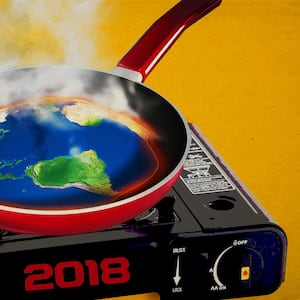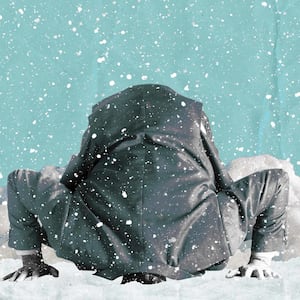Welcome to Debunker, a weekly breakdown of misleading (and sometimes flat-out wrong!) news from the worlds of science, health, and more—for Beast Inside members only.
Over the weekend, the Midwest and Northeast regions of the U.S. faced heavy snow and bitter cold. Sub-freezing temperatures and snowfall have already reportedly killed “several” people in the Midwest, CNN reports, and parts of New England have reportedly suffered “record-breaking” cold temperatures.
The weather also prompted President Trump to revisit one of his tried and true bits of climate misinformation: using the cold weather and snow to cast doubt on global warming.
ADVERTISEMENT
“Large parts of the Country are suffering from tremendous amounts of snow and near record setting cold,” Trump tweeted Sunday. “Amazing how big this system is. Wouldn’t be bad to have a little of that good old fashioned Global Warming right now!”
Trump is far from the first to push this conservative cliché—in fact, it’s such a common tactic among right-wing climate deniers that MSNBC’s Chris Hayes even gave it a name: “snow-trolling.” Other famous examples include Fox News’ Pete Hegseth encouraging Trump to take credit for solving global warming after 22 people died in a bomb cyclone last January, and Sen. James Inhofe (R-OK), who once famously tried to debunk climate change by throwing a snowball on the Senate floor.
But meteorologists warn that equating weather with climate is totally backwards—and that global warming could even be partially responsible for the cold fronts and snow we’ve seen in recent years.
“The extent of [Trump’s] ignorance on this subject never ceases to amaze me,” Jennifer Francis, a senior scientist at the Woods Hole Research Center, told The Daily Beast via email. Representatives from NOAA could not be reached due to the government shutdown.
The first problem with Trump’s tweet is that it conflates weather, the meteorological conditions we experience on a day-to-day basis, with climate, a measurement of long-term changes in that weather.
“Think of a river,” Francis said. “It flows down the hill in a clear direction, but along the way there are swirls and eddies that vary with water level and movements of obstacles in its path. Climate is the river flow; weather is the chaotic swirls.” A few days of below-freezing temperatures doesn’t mean the Earth isn’t warming.
In fact, the data shows just the opposite. Despite harsh winters, 2015, 2016, and 2017 were the three hottest years on record (and 2018 is likely to be the fourth). What’s worse, 17 of the 18 hottest years occurred after 2001.
But if global warming is making the climate hotter, why are some parts of the world still experiencing extremely cold winter weather?
Judah Cohen, an MIT climatologist and a director of senior forecasting at private firm Atmospheric and Environmental Research, a Verisk Business, explains that rising temperatures in the Arctic—which warms even faster than the vast majority of the globe and had its hottest winter on record in 2018—could play a major role in creating severe winter weather in America.
That’s because it affects the flow of the winds that move west to east around the globe, which are known as jet streams, Cohen told The Daily Beast. The streams are driven in part by temperature differentials between the equator and the poles—so when the Arctic warms, the jet stream can weaken. That amplifies the oscillations of the stream, which causes it to push farther north in some places and farther south in others. That movement, Cohen said, can also disturb the polar vortex, an area of extremely cold air that circles near the North Pole.
Cohen noted that this hypothesis isn’t borne out by some models. But he argued that the models don’t approximate the movement of the polar vortex very well, or how changes in the movement of the polar vortex influences weather patterns.
He likened the polar vortex to a spinning top. When it’s knocked off its spin, he said, “The cold air that was previously confined inside the polar vortex bursts out—it’s like a dam bursting, and the cold air will rush to lower latitudes.”
That’s bad news for the Northeastern United States, Francis said. That’s because in recent years, the jet stream has hit the western side of the country up near Alaska, then “plunge[d] southward” as it crossed the eastern half of the country, allowing the cooler air that’s normally confined farther north to travel down to the Northeastern United States.
There’s no conclusive proof that global warming in the Arctic is what’s causing this weather change, and some scientists contest this explanation. But multiple studies have documented the correlation between rising temperatures in the Arctic and more severe cold patterns in the Northeast.
One study published in 2018 in the journal Nature Communications, co-authored by Francis, Cohen, and another author, studies temperature data dating back to 1950. The researchers found that, “As the Arctic transitions from a relatively cold state to a warmer one, the frequency of severe winter weather in mid-latitudes increases through the transition.” That’s especially true in the Northeast, the authors note. And it’s a drastic change—the researchers found that severe winter weather is two to four times more likely to occur when the Arctic is unusually warm than it is when it’s unusually cold, according to a press release.
A second paper, published in the journal Nature Geoscience in 2017, came to a similar conclusion. Researchers found that periods of warmer weather in the Arctic over the previous three decades coincided with colder temperatures in the northeastern United States.
“Ironically, as the Arctic gets warmer, we tend to see these kinds of severe winters—especially in the Northeast of the U.S.—more commonly,” Anna Michalak, one of the study’s co-authors and a climatologist at the Carnegie Institute for Science, told The Daily Beast. Michalak noted that colder winters aren’t the only extreme weather consequence—climate change has also been linked to droughts, heatwaves, and increased rainfall.
It also tends to mean more snow. Michalak explained that when temperatures rise, especially around the Great Lakes, the lakes tend to freeze “not at all, less, or later.” When there’s more liquid water, there’s more evaporation—so if it’s cold enough, there could be more severe snowfall.
Michalak was careful to emphasize that it’s impossible to attribute any specific weather event—like this most recent bout of cold, or the storm that created Sen. Inhofe’s snowball—to global warming. But that doesn’t mean Trump is right.
“That uncertainty about those kinds of specifics in no way undermines the certainty about the basic principles,” Michalak said, “and the underlying physical science of climate change itself.”
Michael Mann, a professor of atmospheric science at Penn State University, agrees. “The truth is likely the opposite of what climate change deniers, and those like Donald Trump who are beholden to fossil fuel interests, want you to think,” Mann told The Daily Beast via email. “And the cost of this denial and delay is being borne by all of us, who are already suffering the consequences of dangerous climate change impacts.”







